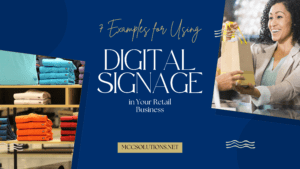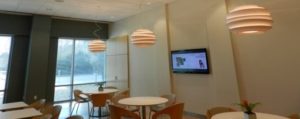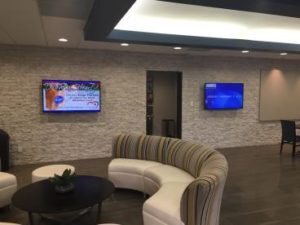
By now, you are sure to have seen digital signage in some form in your daily life. From digital billboards to kiosks in the doctor’s office or hospital, digital signage is everywhere. For example, the menu boards at your local fast food joints are most likely digital signage. This allows the business to maximize space and place certain products or offers in prominent, eye-catching positions. These digital boards also make it easy for business to change their menu quickly and simply.
So how does this work in other retail businesses? A clothing store isn’t going to display a list of their products and prices on a digital sign. That wouldn’t be helpful to someone standing in front of the product. A car dealership doesn’t need to show the price or feature list of the vehicle since that information is available on the sticker on the car. What does digital signage offer to these types of retail businesses?
Here are 7 examples of how retail businesses can use digital signage to drive business and maximize customer engagement:
- Moving Content vs Static Images
Using digital content to engage your customers from the moment they walk through the door is probably the biggest benefit to digital signage. The human eye is attracted to movement naturally, so using displays with flowing content instead of static signs or photographs will naturally draw your customer’s attention.
Imagine you are standing in a retail clothing store. To your right is a table full of neatly folded blue jeans. On top of that table is a static display with a model posed wearing a pair of the jeans. On your left, is the same type of display, but instead of a static photo, there is a digital display showing multiple different models in moving video content. They are still wearing the jeans, but they are moving. Not only is your eye naturally drawn toward the movement, but you are also able to better visualize what the jeans would look like on a person from multiple angles and positions. This is something a static photo cannot accomplish.
- Interactive Sales
Now imagine, you cannot find your size on the neatly presented table. The salesperson comes over to assist you and touches the screen on the display. The models disappear and the salesperson brings up the store’s website where they are able to locate and order a pair of those jeans in your size to be shipped to the store or your home.
This could also be useful at any other type of retail store. For example, a car dealership could turn one wall of their showroom into a video wall with video footage of their vehicles features. This custom content would not only engage the customer, but would assist the salesperson by giving them on the spot references and facts to reinforce the sales pitch.
- Customized Content
Marketing materials are expensive. Unless you employ an in house graphic designer/photographer, getting good content to use for static displays in your business can be involved and costly and changing out the static displays for new content takes employees away from other tasks. With digital signage, changing and updating content is made simple through the signage software. You can make the content as complex or as simple as you want. The important thing is to make it your own. Engage your customers with information specific to your store or business. Did your triple chocolate cupcakes just win a local award or get a great review on Yelp? Adding this to your digital signage is easy and will grab your customer’s attention.
Have an Instagram account? Put your feed up on one of your displays and let your customers know if they tag your business in a photo, it will be displayed in the store. Not only will this draw interest in your Instagram account, but will most likely result in repeat customers who want to see their photos displayed in your store. And it does not cost an arm and a leg for professional photos of your products.
- Targeted Advertising
In this day and age, just about everyone is connected to the internet 24/7 with their smartphones. This gives advertisers a great tool for targeting advertising to the specific interests of the users. A new trend called presence detection is making its way into digital advertising. Presence detection means that retailers can use signage in your physical proximity to display ads specific to your interests or previous shopping habits. To use the clothing store example again, imagine walking into a department store in the men’s department. Traditionally, you would expect to see advertisements for men’s clothing. With presence detection, your phone would alert the display to your proximity, and the display would switch to something more geared to your interest. Maybe you spent the morning looking at tools on Google, or shopping for shoes on Amazon. The display would show you these types of ads with directions to that department. It may sound like science fiction, but it is real and it is becoming more and more popular and a great way for business to engage customers with the information they actually want.
- Modern Window Displays
As a former retail clothing store worker, one of my favorite responsibilities was dressing the window displays, however it took days to get all the props correct and mannequins properly dressed and posed. That was at least 2 days that I was not on the floor making money for the store.
A better use of that window space (and my time) would have been a video wall displaying a moving background in front of which the mannequins could be posed. Or incorporating the digital displays into the window display to grab customer attention. With easily modified content, the time needed to set up the display could potentially be reduced. And the space needed to store all those window props and static signs could be converted into additional sales floor space.
6. Employee Training and Information Distribution
Finding time for training employees is not always easy. Placing digital signage in hallways, back offices, or breakrooms, can be an easy way to display training videos to reinforce in person or hands on training. Playing this on a loop with other content means employees are constantly hearing this message.

These displays are good for company information distribution and motivational content also. Here at MCC, we have a digital display in our main hallway that displays our MCC Teammate Core Values intermixed with our Sales and Technical staff quota and sales statistics. We are also able to display which clients are currently being assisted by our technicians in real-time which helps our sale staff keep informed about their clients.
7. Entertaining Customers
No matter how hard we try, our customers will inevitably have to wait at some point in time. Make this wait time more engaging with your digital content. Instead of waiting customers watching their phones, give them something engaging to watch while they wait. Some examples are digital displays in waiting rooms or on tables that offer games or trivia. Use your displays to get customers engaged with your social media accounts by having a scavenger hunt. Point your waiting guests to your Facebook page and have them find a few items around your office or store that can be photographed and shared on Facebook. Or have them show a social media check-in at a specific location inside the store and receive branded swag.

These are just a few of the many ways digital signage can benefit a retail business. The possibilities are truly limited only by your imagination.
If you are interested in seeing how digital signage can help grow your business or drive your sales, request a demo today or give our sales team a call @ 866-805-5893.


